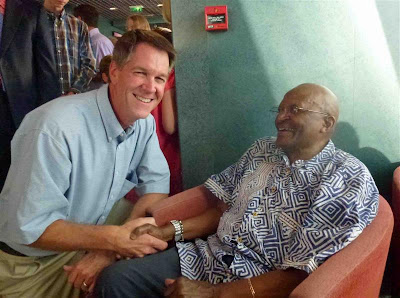Blog Entry #27: South Africa Day 6: Robben Island and Bishop Desmond Tutu
Wednesday, September 28, 2011
Our final day in South Africa, Pat and I boarded the Sikhululekile (name of South Africa’s anthem) ferry for a long-awaited trip across Table Bay to Robben Island. When I had previously visited Capetown nearly 20 years ago in January, 1982 with a delegation from Union Theological Seminary, the final political prisoners had just been released from Robben Island as recently released ANC leader Nelson Mandela entered into negotiations with the apartheid government of F. W. de Klerk to end apartheid and return South Africa to democratic rule. But in 1992 Robben Island remained a prison, and off limits to visitors. Now 20 years later and 16+ years into democratic rule in South Africa, I was anxious to see this infamous island prison that had imprisoned both former President Nelson Mandela and current President Jacob Zuma.
 |
| Students awaiting Ferry to Robben Island; Semester at Sea ship MV Explorer behind |
As we awaited our 11:00 am departure, it was moving to see the groups of school children who had traveled from all over South Africa line up for the boat ride across the bay. I spoke with one schoolteacher who had traveled 15 hours by bus with 40 of his students for the opportunity to see where Nelson Mandela and so many other ANC members had been imprisoned. He spoke movingly of his excitement at finally being able to make this pilgrimage. I pointed out the Semester-at-Sea ship in harbor as we moved by it, and then we entered the choppy waters of Table Bay (I had forgotten how much more a small boat rocks than our big ship!).
 |
| The last Political Prisoners leave |
Twenty minutes later the low profile of Robben Island began to fill the horizon. The Dutch in the 17th century were the first to use the island to house political prisoners, a tradition that continued through apartheid until the final political prisoner was released in April, 1991. As we entered the harbor, we saw the Blouberg anchored there, beneath a large photo showing the final group of political prisoners in its bow, triumphantly entering Capetown’s harbor upon their release.
 |
| Wall outside Mandela's cell |
 |
| Former Political Prisoners at Robben Island |
 |
| Limestone Quarry |
Tours of the Island are typically conducted by ex-prisoners turned tour guides, who are able to supplement the official information with personal anecdotes about their imprisonment. When we went to the limestone quarry illustrated so vividly in the movie Invictus (with Morgan Freeman as Nelson Mandela), our guide spoke of the seven years he spent working in the quarry, and the eye damage that nearly all prisoners who worked there suffered from repeated exposure to the blinding lime walls. But most of what he emphasized was how the prisoners organized to turn the Lime Quarry into “Robben Island University,” using the time there for political education among the prisoners. He mentioned that some of their Afrikaner guards were sympathetic to their prisoners and allowed them to proceed relatively unimpeded, while others repressed them ruthlessly.
 |
| Sipo explaining prison food system divided by race |
 |
| Nelson Mandela's cell |
 |
| Table Mountain behind Maximum Security prison |
Following our return to the ship that afternoon, we prepared for what for me will certainly be one of the main highlights of this 4-month voyage: a meeting with Nobel Peace Prize winner and contemporary saint Archbishop Desmond Tutu. Tutu has long been a friend to Semester at Sea and only 2 years ago sailed for 4 months on one of the semester voyages, so he regularly visits the ship when it is in Capetown. At a reception for the faculty and staff, I had the opportunity to speak to him for a few minutes, and talk to him about my time studying at Union Theological Seminar with scholars such as James Cone and Cornell West who had been prominent opponents of apartheid. What is striking about being in the presence of Bishop Tutu is the warmth and humor that radiates from him, instantly making one feel at home.
Later that even Bishop Tutu spoke to the students for nearly an hour before the most packed audience I have yet seen in the Union lecture hall. To say that his audience was rapt in its attention to what he spoke is an understatement. He expressed his hope for the future in the current students’ generation and challenged each of them to take this amazing experience each has been given and apply it to the challenges our earth community faces.











How wonderful that you met and talked with and heard Bishop Tutu, especially at the end of your day at Robben Island! I hope his health is better these days. The world needs his voice!
ReplyDeleteIt was truly an amazing experience! This week is his 80th birthday, and unfortunately the South African govt denied the Dalai Lama a visa to be there -- the influence of the Chinese government, no doubt. We were so fortunate to be with him.
ReplyDelete